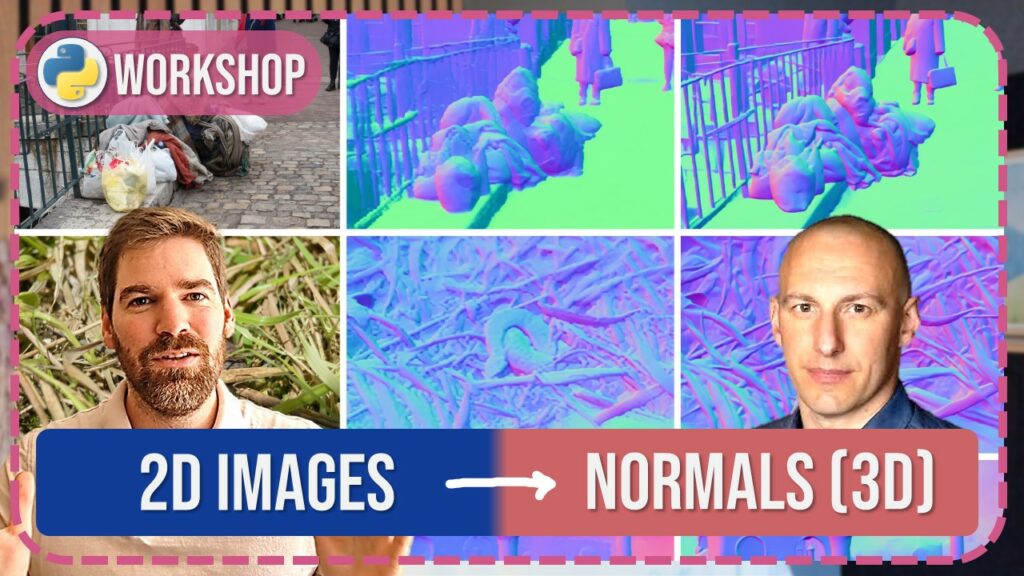This Live Course / Workshop series will give you a linear, hands-on solution for turning a monocular 2D Image to 3D Model. This means that you will be able to take any AI-generated image, and make it a 3D Model.
3D Reconstruction: 2D Image to 3D Model
Pulling objects straight out of our photos, generated with AI or not, is fantastic. The goal of this course package is specifically to transform ordinary 2D images into first-pass 3D models. We achieve this in three guided steps:
- Monocular Depth Estimation with Python: Master the art of creating depth maps, the foundation for building 3D models, using Python’s power.
- 3D Reconstruction from Single Image with DepthAnything: Discover DepthAnything, a user-friendly tool that lets you build 3D models from a single image – no fancy camera setups required!
- 2D Image to 3D Normals with DSINE: Take your 3D creations to the next level by crafting realistic surface normals with DSINE, adding detail to your models.
–🐍 Step 1 –
Monocular Depth Estimation with Python
Let us first focus 2D image to 3D Model using deep learning and Python. In this phase, we follow six steps to achieve this using five Python libraries: Pytorch, Pillow, matplotlib, Transformers, and open3D.
Let us cover how to prepare the environment, take or generate an image, preprocess the image, estimate the depth of the image, generate a point cloud, and convert the point cloud to a 3D mesh. This tutorial is a step-by-step guide to using the power of deep learning to create 3D models from your pictures using a Depth Estimation Model.
If you want to deepen the topic, here is the article with resources: Single Image to 3D Model
-🐍 Step 2 –
3D Reconstruction from 2D Image to 3D Model with DepthAnything
This second step is about creating a 3D point cloud from a single image using a the same monocular depth estimation technique. In this experiments, we will use Vision Transformers, monocular depth estimation, and 3D transformation to create a 3D point cloud from a single image. And we will use the model called: DepthAnything.
We will also showcase ROS, which shows how to create a 3D point cloud of a room from a single image or a video feed in real time.
You will find the DepthAnything article with the resources (code, dataset, materials) here: 3D Workshop: Season 1
🦚 Tech News: There is a new version of DepthAnything, originally called DepthAnythingV2 that you can find here: Project Page. This is a great way to improve 2D Image to 3D Model Reconstruction.
-🐍 Step 3 –
2D Image to 3D Normals with DSINE
Finally, let us explore how we could turn a 2D Image into 3D Normals. For this specific step, we will use the architecture called DSINE:

You will find the DSINE article with the resources (code, datasets, material) here: 3D Workshop: Season 1
2D Image to 3D Model: Conclusion
This 3D Course Package is a fantastic way to very quickly create a working solution to turn 2D Images into 3D Models. I am looking forward to seeing what you create with such tech, and feel free to come back as I update with new solutions that comes in.
My 3D Recommendation 🍉
Generating 3D Point Clouds from a a Single Image is fantastic. It opens up a lot of horizons… for Creativity purposes only (at this stage). If you seek a more metrically controlled approach, at scale, I highly recommend getting expertise with Photogrammetry to unlock Multi-View Reconstruction. It is more constraining than single images but provides a much better geometric base layer. If you want to use it in your solutions, I recommend getting on the 3D Collector’s Pack for the full experience, or the 3D Reconstructor Course if you want the limited to Reconstruction side of things.

If you want to get a tad more toward application-first or depth-first approaches, I curated several learning tracks and courses on this website to help you along your journey. Feel free to follow the ones that best suit your needs, and do not hesitate to reach out directly to me if you have any questions or if I can advise you on your current challenges!
Open-Access Knowledge
- Medium Tutorials and Articles: Standalone Guides and Tutorials on 3D Data Processing (5′ to 45′)
- Research Papers and Articles: Research Papers published as part of my public R&D work.
- Email Course: Access a 7-day E-Mail Course to Start your 3D Journey
- Youtube Education: Not articles, not research papers, open videos to learn everything around 3D.
3D Online Courses
- 3D Python Crash Course (Complete Standalone). 3D Coding with Python.
- 3D Reconstruction Course (Complete Standalone): Open-Source 3D Reconstruction (incl. NERF and Gaussian Splatting).
- 3D Point Cloud Course (Complete Standalone): Pragmatic, Complete, and Commercial Point Cloud Workflows.
- 3D Object Detection Course (3D Python Recommended): Practical 3D Object Detection with 3D Python.
- 3D Deep Learning Course (3D Python Recommended): Most-Advanced Course for Top AI Engineers and Researchers
3D Learning Tracks
- 3D Segmentation Deck: From Classical 3D Segmentation to 3D Deep Learning and Unsupervised Applications
- 3D Collector’s Pack: Complete Course Track to address both 3D Application and Code Layers.
